Efficient Support Vector Regression for Wideband DOA Estimation Using a Genetic Algorithm
Abstract
1. Introduction
- An efficient SVR architecture for wideband DOA estimation via a GA is proposed. It exhibits superior estimation and resolution capabilities, along with strong generalization performance. The results of experiments confirm the superior performance and efficiency of the proposed network compared to typical existing algorithms such as RSS-MUSIC, L1-SVD, and CWSVR.
- We have employed a coherent focusing operation to initially extract the features from the covariance matrix and ensure the preservation of essential signal features. Multiband data are projected onto a designated reference frequency point, which substantially lowers the dimensionality of the input signals to the network. In particular, the dimensionality of the input features does not scale with the number of sub-bands, making the method well suited for broadband and ultra-broadband signals. This not only substantially reduces the model training time and system storage requirements but also makes the method especially beneficial in resource-limited environments.
- The performance of SVR models is highly sensitive to parameter selection, particularly the regularization and kernel function parameters. Here, we employ a GA to optimize the model parameters due to its notable advantages, including global optimization capability, strong adaptability, and effectiveness in mitigating overfitting. The optimized SVR model exhibits improved fitting and generalization performance on the training data, leading to a significant improvement in DOA estimation.
2. Wideband Array Signal Model
3. The Proposed Method
3.1. Data Preprocessing
3.2. Optimization of SVR Parameters
3.2.1. Initializing the Population
3.2.2. Calculating Adaptation
3.2.3. Selection
3.2.4. Crossover
3.2.5. Mutation
3.2.6. Circulation
3.3. Multiband Joint Direction-Finding Method Based on SVR
| Algorithm 1: Broadband signal processing and parameter optimization |
| Inputs Outputs
|
| Return . |
4. Performance Analysis
4.1. DOA Estimation Results
4.2. Resolution Performance
4.3. Statistical Performance
4.4. Generalization Performance
4.5. Comparison of Training and Testing Times
5. Conclusions and Discussion
Author Contributions
Funding
Institutional Review Board Statement
Informed Consent Statement
Data Availability Statement
Conflicts of Interest
References
- Fan, W.; Zhang, X.; Jiang, B. A New Passive Sonar Bearing Estimation Algorithm Combined with Blind Source Separation. In Proceedings of the 2010 Third International Joint Conference on Computational Science and Optimization, Huangshan, China, 28–31 May 2010; Volume 1, pp. 15–18. [Google Scholar]
- Myronchuk, O.; Brusko, A.; Oliinyk, M. Modeling of Methods for Determining the Direction of Arrival of Radio Signals Using Phased Antenna Arrays. In Proceedings of the 2024 IEEE 17th International Conference on Advanced Trends in Radioelectronics, Telecommunications and Computer Engineering (TCSET), Lviv, Ukraine, 8–12 October 2024; pp. 1–6. [Google Scholar]
- Peng, J.; Nie, W.; Li, T.; Xu, J. An End-to-End DOA Estimation Method Based on Deep Learning for Underwater Acoustic Array. In Proceedings of the OCEANS 2022, Hampton Roads, VA, USA, 17–20 October 2022; pp. 1–6. [Google Scholar]
- Xie, N.; Zhou, Y.; Xia, M.; Tang, W. Fast Blind Adaptive Beamforming Algorithm With Interference Suppression. IEEE Trans. Veh. Technol. 2008, 57, 1985–1988. [Google Scholar]
- Bai, M.; Liu, H.; Chen, H.; Gu, S.; Zhang, Z. Intelligent Beamforming Algorithm with Low Data Quality. In Proceedings of the 2019 3rd International Conference on Electronic Information Technology and Computer Engineering (EITCE), Xiamen, China, 18–20 October 2019; pp. 1331–1337. [Google Scholar]
- Steinwandt, J.; de Lamare, R.C.; Wang, L.; Song, N.; Haardt, M. Widely Linear Adaptive Beamforming Algorithm Based on the Conjugate Gradient Method. In Proceedings of the 2011 International ITG Workshop on Smart Antennas, Aachen, Germany, 24–25 February 2011; pp. 1–4. [Google Scholar]
- Weigang, H.; Fan, Z.; Zhenglin, L.; Shuyuan, L. Study of Improved Multiple Signal Classification Algorithm Based on Coherent Signal Sources. In Proceedings of the 2016 World Automation Congress (WAC), Rio Grande, TX, USA, 31 July–4 August 2016; pp. 1–4. [Google Scholar]
- Tang, X.; Hong, R.; Zhu, C.; Zuo, L.; Qi, X.; Xu, Z. DOA Estimation for Coprime Array via Capon-MUSIC Algorithm. In Proceedings of the 2024 IEEE MTT-S International Wireless Symposium (IWS), Beijing, China, 16–19 May 2024; pp. 1–3. [Google Scholar]
- Zhou, X.; Zhu, F.; Jiang, Y.; Zhou, X.; Tan, W.; Huang, M. The Simulation Analysis of DOA Estimation Based on MUSIC Algorithm. In Proceedings of the 2020 5th International Conference on Mechanical, Control and Computer Engineering (ICMCCE), Harbin, China, 25–27 December 2020; pp. 1483–1486. [Google Scholar]
- Chowdhury, M.W.T.S.; Mastora, M. Performance Analysis of MUSIC Algorithm for DOA Estimation with Varying ULA Parameters. In Proceedings of the 2020 23rd International Conference on Computer and Information Technology (ICCIT), Dhaka, Bangladesh, 19–21 December 2020; pp. 1–5. [Google Scholar]
- Li, M.; Lu, Y. Genetic Algorithm Based Maximum Likelihood DOA Estimation. In Proceedings of the RADAR 2002, Edinburgh, UK, 15–17 October 2002; pp. 502–506. [Google Scholar]
- Chen, C.E.; Lorenzelli, F.; Hudson, R.E.; Yao, K. Stochastic Maximum-Likelihood DOA Estimation in the Presence of Unknown Nonuniform Noise. IEEE Trans. Signal Process. 2008, 56, 3038–3044. [Google Scholar] [CrossRef]
- Koppelaar, A.G.; Suvarna, A.R. Sequential DoA estimation using Recursive DML. In Proceedings of the 2024 21st European Radar Conference (EuRAD), Paris, France, 25–27 September 2024; pp. 188–191. [Google Scholar]
- Wu, T.; Deng, Z.; Hu, X.; Li, A.; Xu, J. DOA Estimation of Incoherently Distributed Sources Using Importance Sampling Maximum Likelihood. J. Syst. Eng. Electron. 2022, 33, 845–855. [Google Scholar] [CrossRef]
- Fayad, Y.; Wang, C.; Cao, Q. Improved ESPRIT Method Used for 2D-DOA Estimation in Tracking Radars. In Proceedings of the 2016 European Radar Conference (EuRAD), London, UK, 5–7 October 2016; pp. 113–116. [Google Scholar]
- Karmous, N.; El Hassan, M.O.; Choubeni, F. An improved esprit algorithm for DOA estimation of coherent signals. In Proceedings of the 2018 International Conference on Smart Communications and Networking (SmartNets), Yasmine Hammamet, Tunisia, 16–17 November 2018; pp. 1–4. [Google Scholar]
- Li, S.; Zhang, Y.; Edwards, R. Two dimension DOA ESPRIT algorithm based on parallel coprime arrays and complementary sequence in MIMO communication system. In Proceedings of the 2019 IEEE International Conference on Signal, Information and Data Processing (ICSIDP), Chongqing, China, 11–13 December 2019; pp. 1–4. [Google Scholar]
- Xing, C.; Dong, S.; Wan, Z. Direction-of-Arrival Estimation Based on Sparse Representation of Fourth-Order Cumulants. IEEE Access 2023, 11, 128736–128744. [Google Scholar] [CrossRef]
- Zhang, J.; Xu, L.; Chu, P.; You, Q.; Liao, B. Sparse Representation Based DOA Estimation of Mixed Circular and Non-Circular Signals. In Proceedings of the IET International Radar Conference (IRC 2023), Chongqing, China, 3–5 December 2023; Volume 2023, pp. 2605–2610. [Google Scholar]
- Xiao, W.; Li, Y.; Zhao, L.; de Lamare, R.C. Robust DOA Estimation Against Outliers via Joint Sparse Representation. IEEE Signal Process. Lett. 2024, 31, 2015–2019. [Google Scholar] [CrossRef]
- Krim, H.; Viberg, M. Two Decades of Array Signal Processing Research: The Parametric Approach. IEEE Signal Process. Mag. 1996, 13, 67–94. [Google Scholar] [CrossRef]
- Haykin, S. Cognitive Radar: A Way of the Future. IEEE Signal Process. Mag. 2006, 23, 30–40. [Google Scholar] [CrossRef]
- Fan, R.; Si, C.; Yi, W.; Wan, Q. YOLO-DoA: A New Data-Driven Method of DoA Estimation Based on YOLO Neural Network Framework. IEEE Sens. Lett. 2023, 7, 1–4. [Google Scholar] [CrossRef]
- Yang, T.; Wang, L.; Li, X. DOA Estimation Based on Deconvolution Beamforming-Based Unrolling Neural Network. In Proceedings of the 2022 IEEE International Conference on Artificial Intelligence and Computer Applications (ICAICA), Dalian, China, 24–26 June 2022; pp. 305–310. [Google Scholar]
- Ping, Z. DOA Estimation Method Based on Neural Network. In Proceedings of the 2015 10th International Conference on P2P, Parallel, Grid, Cloud and Internet Computing (3PGCIC), Krakow, Poland, 4–6 November 2015; pp. 828–831. [Google Scholar]
- Guo, B.; Zhen, J.; Zhang, X. Direction of Arrival Estimation Based on Support Vector Regression. In Proceedings of the Communications, Signal Processing, and Systems: 8th International Conference on Communications, Signal Processing, and Systems, Urumqi, China, 20–22 July 2019, 8th ed.; Springer: Berlin/Heidelberg, Germany, 2020; pp. 1169–1173. [Google Scholar]
- Wang, J.; Wu, Y.; Deng, X.; Zhang, L.; Xia, D.; Zhou, Q. A Single Snapshot DOA Estimation Method Based on ADMM-Net. IEEE Geosci. Remote Sens. Lett. 2024, 21, 1–5. [Google Scholar] [CrossRef]
- Zhang, Z.; Qu, X.; Li, W.; Miao, H.; Liu, F. DOA Estimation Method Based on Unsupervised Learning Network With Threshold Capon Spectrum Weighted Penalty. IEEE Signal Process. Lett. 2024, 31, 701–705. [Google Scholar] [CrossRef]
- Zhao, Y.; Fan, X.; Liu, J.; Li, Y.; Yao, L.; Wang, J. Efficient 2D-DOA Estimation Based on Triple Attention Mechanism for L-Shaped Array. Sensors 2025, 25, 2359. [Google Scholar] [CrossRef]
- Zhang, J.; Dai, J.; Ye, Z. An Extended TOPS Algorithm Based on Incoherent Signal Subspace Method. Signal Process. 2010, 90, 3317–3324. [Google Scholar] [CrossRef]
- Wax, M.; Shan, T.J.; Kailath, T. Spatio-temporal spectral analysis by eigenstructure methods. IEEE Trans. Acoust. Speech Signal Process. 1984, 32, 817–827. [Google Scholar] [CrossRef]
- Bai, Y.; Li, J.; Wu, Y.; Wang, Q.; Zhang, X. Weighted Incoherent Signal Subspace Method for DOA Estimation on Wideband Colored Signals. IEEE Access 2019, 7, 1224–1233. [Google Scholar] [CrossRef]
- Wang, H.; Kaveh, M. Coherent Signal-Subspace Processing for the Detection and Estimation of Angles of Arrival of Multiple Wide-Band Sources. IEEE Trans. Acoust. Speech Signal Process. 1985, 33, 823–831. [Google Scholar] [CrossRef]
- Hung, H.; Kaveh, M. Focussing Matrices for Coherent Signal-Subspace Processing. IEEE Trans. Acoust. Speech Signal Process. 1988, 36, 1272–1281. [Google Scholar] [CrossRef]
- Wang, H.; Kaveh, M. On the performance of signal-subspace processing–Part II: Coherent wide-band systems. IEEE Trans. Acoust. Speech Signal Process. 1987, 35, 1583–1591. [Google Scholar] [CrossRef]
- Zhang, R.; Shim, B.; Wu, W. Direction-of-arrival estimation for large antenna arrays with hybrid analog and digital architectures. IEEE Trans. Signal Process. 2021, 70, 72–88. [Google Scholar] [CrossRef]
- Zhang, R.; Chen, G.; Cheng, L.; Guan, X.; Wu, Q.; Wu, W.; Zhang, R. Tensor-based Channel Estimation for Extremely Large-Scale MIMO-OFDM with Dynamic Metasurface Antennas. IEEE Trans. Wirel. Commun. 2025. [Google Scholar] [CrossRef]
- Mack, W.; Bharadwaj, U.; Chakrabarty, S.; Habets, E.A.P. Signal-Aware Broadband DOA Estimation Using Attention Mechanisms. In Proceedings of the ICASSP 2020—2020 IEEE International Conference on Acoustics, Speech and Signal Processing (ICASSP), Barcelona, Spain, 4–8 May 2020; pp. 4930–4934. [Google Scholar]
- Zhu, W.; Zhang, M.; Wu, C.; Zeng, L. Broadband Direction of Arrival Estimation Based on Convolutional Neural Network. IEICE Trans. Commun. 2020, E103B, 148–154. [Google Scholar] [CrossRef]
- Zhu, W.; Zhang, M. A Deep Learning Architecture for Broadband DOA Estimation. In Proceedings of the 2019 IEEE 19th International Conference on Communication Technology (ICCT), Xi’an, China, 16–19 October 2019; pp. 244–247. [Google Scholar]
- Ma, Y.; Zhang, J.; Chu, P.; Liao, B. Deep Learning Based Broadband DOA Estimation. In Proceedings of the 2021 15th European Conference on Antennas and Propagation (EuCAP), Dusseldorf, Germany, 22–26 March 2021; pp. 1–5. [Google Scholar]
- Wu, L.-L.; Huang, Z.-T. Coherent SVR Learning for Wideband Direction-of-Arrival Estimation. IEEE Signal Process. Lett. 2019, 26, 642–646. [Google Scholar] [CrossRef]
- Han, K.; Nehorai, A. Wideband Gaussian source processing using a linear nested array. IEEE Signal Process. Lett. 2013, 20, 1110–1113. [Google Scholar]
- Valaee, S.; Kabal, P. Wideband Array Processing Using a Two-Sided Correlation Transformation. IEEE Trans. Signal Process. 1995, 43, 160–172. [Google Scholar] [CrossRef] [PubMed]
- Hu, Z.; Wang, M.; Huang, X. Parameter Selection of Support Vector Regression Based on Particle Swarm Optimization. In Proceedings of the 2010 IEEE International Conference on Granular Computing, San Jose, CA, USA, 14–16 August 2010; pp. 834–838. [Google Scholar]
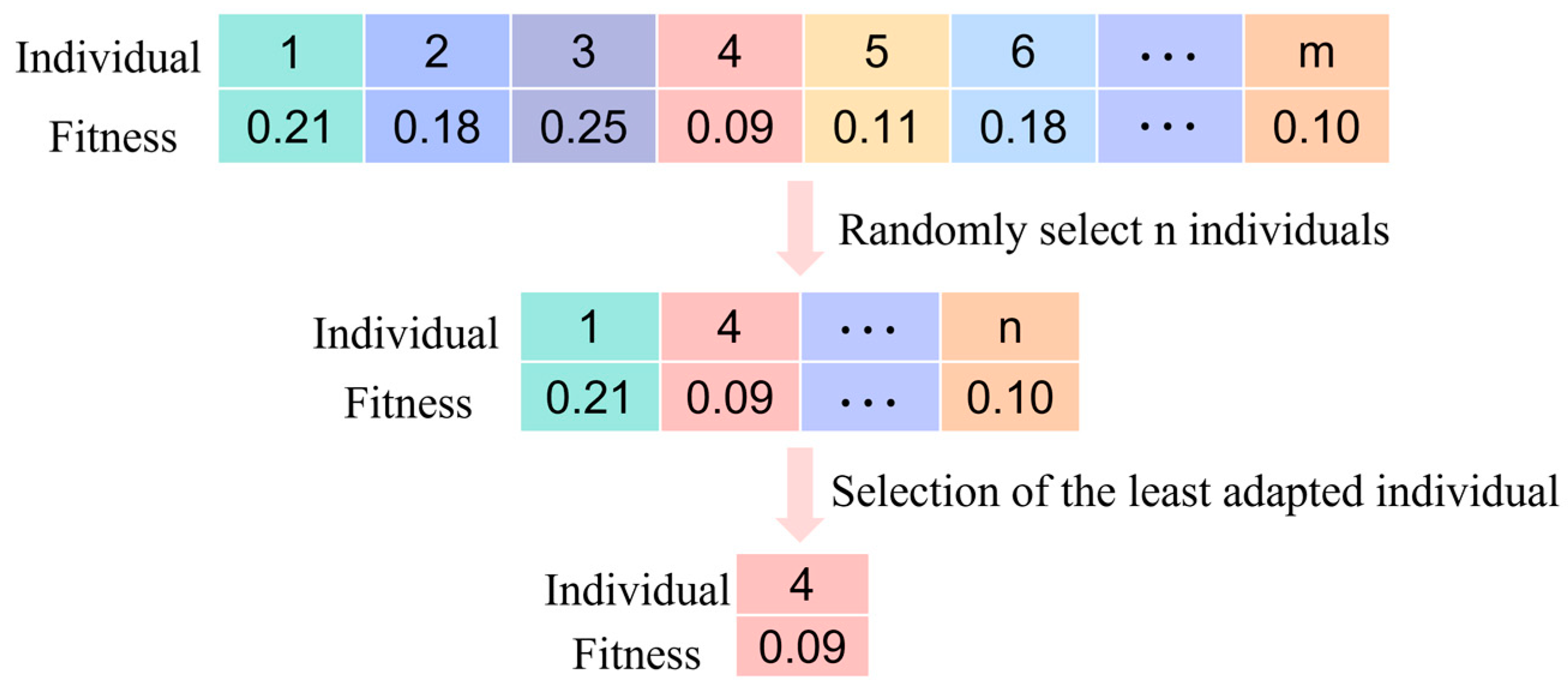

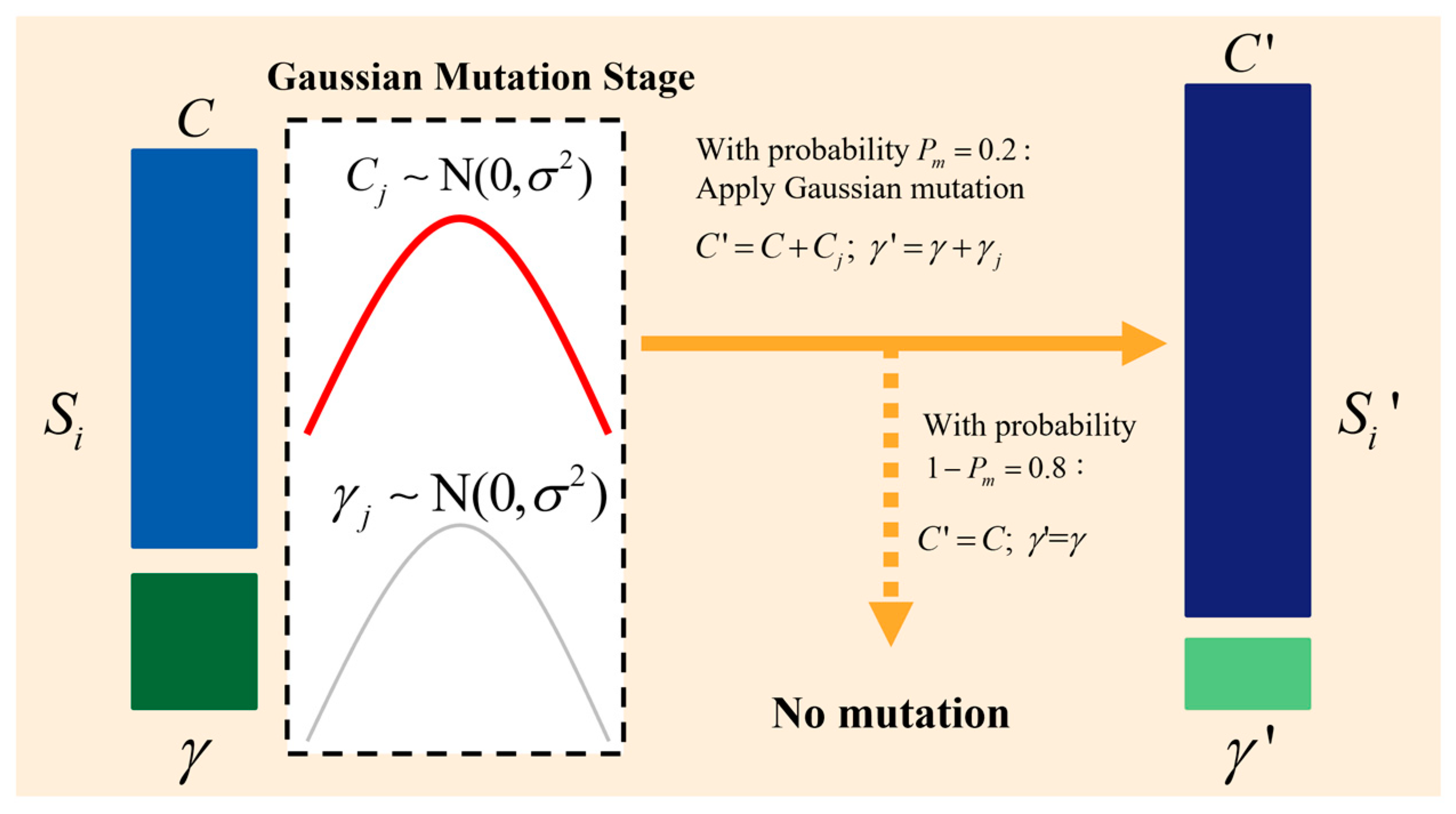
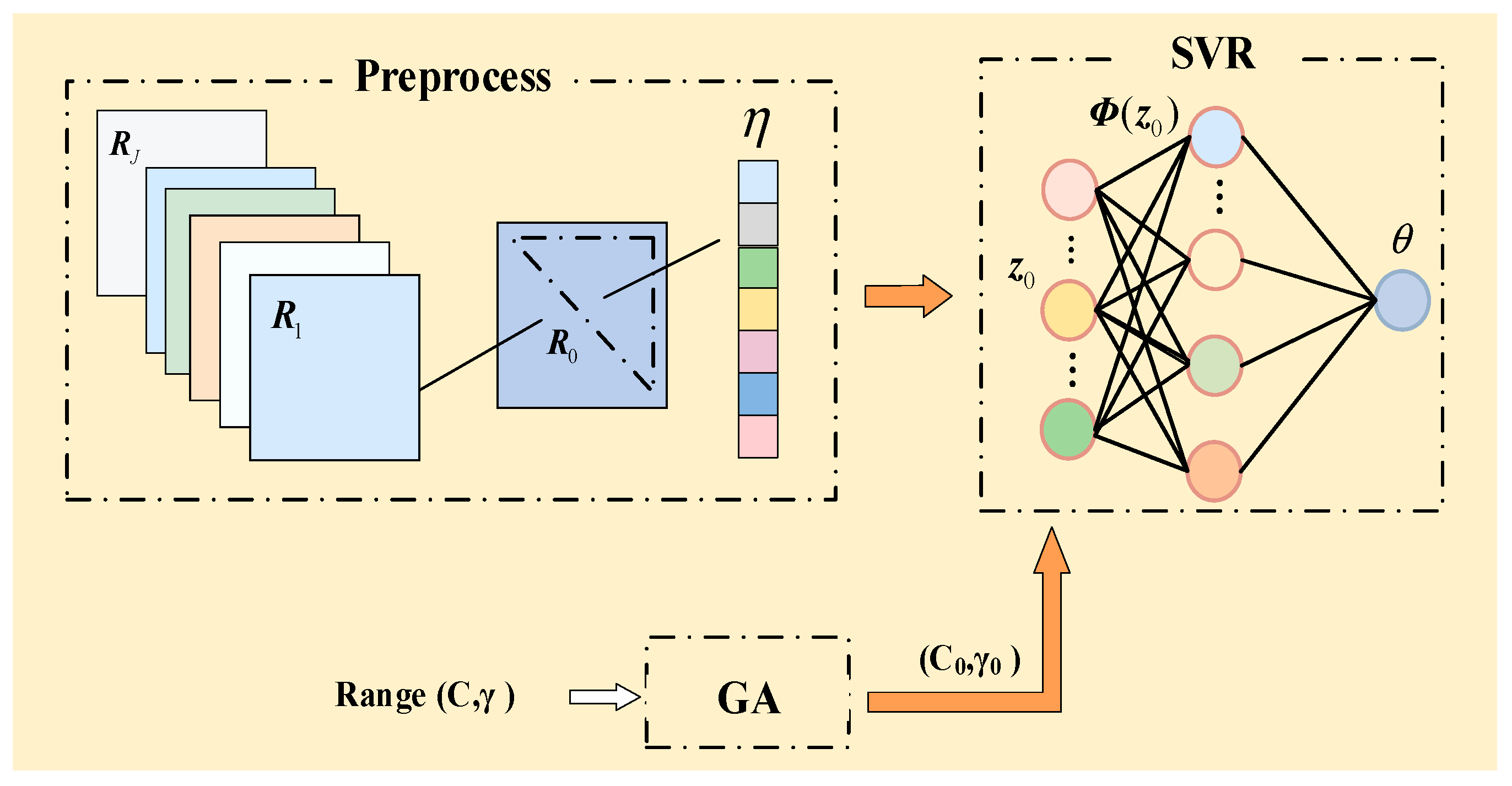


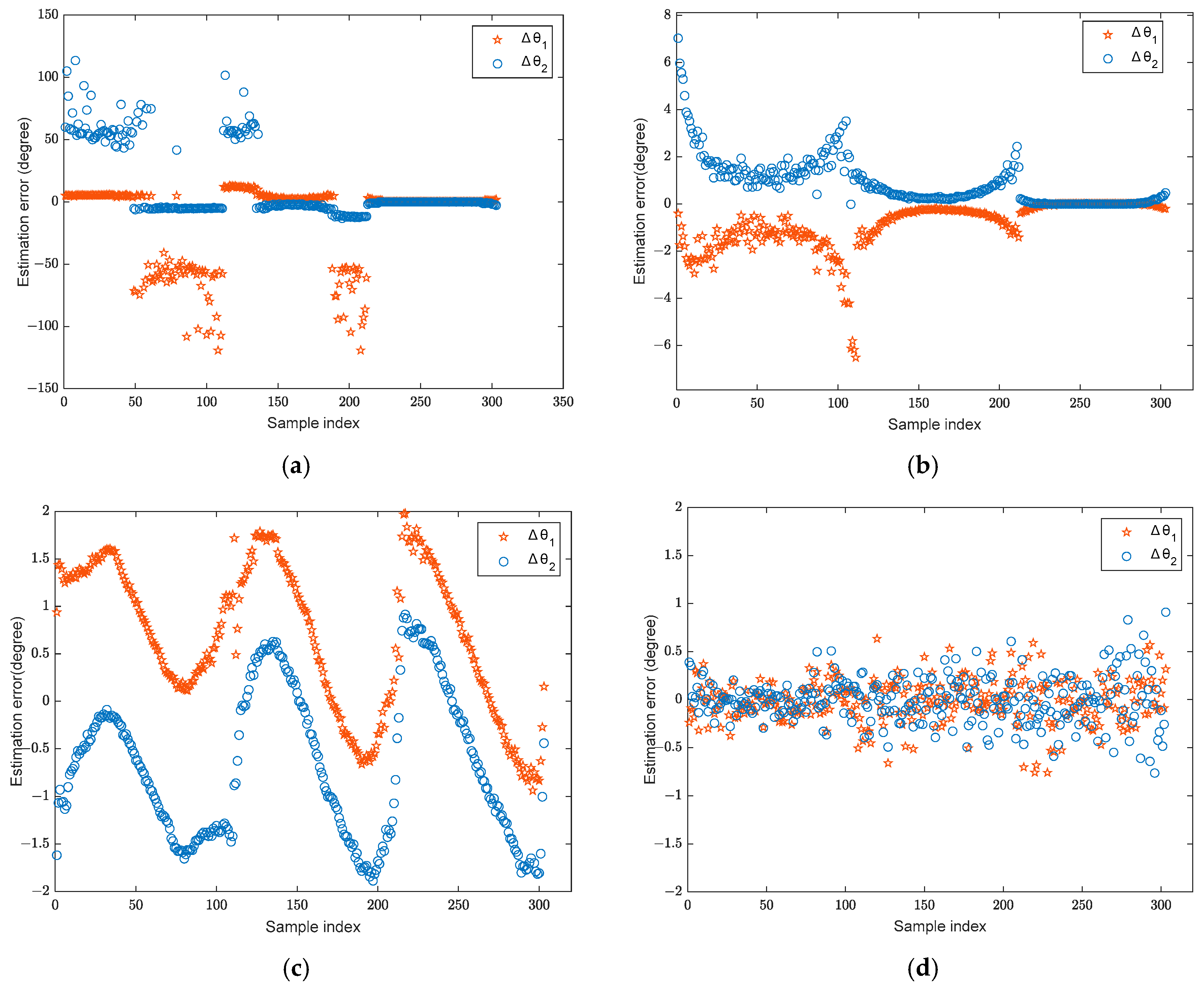

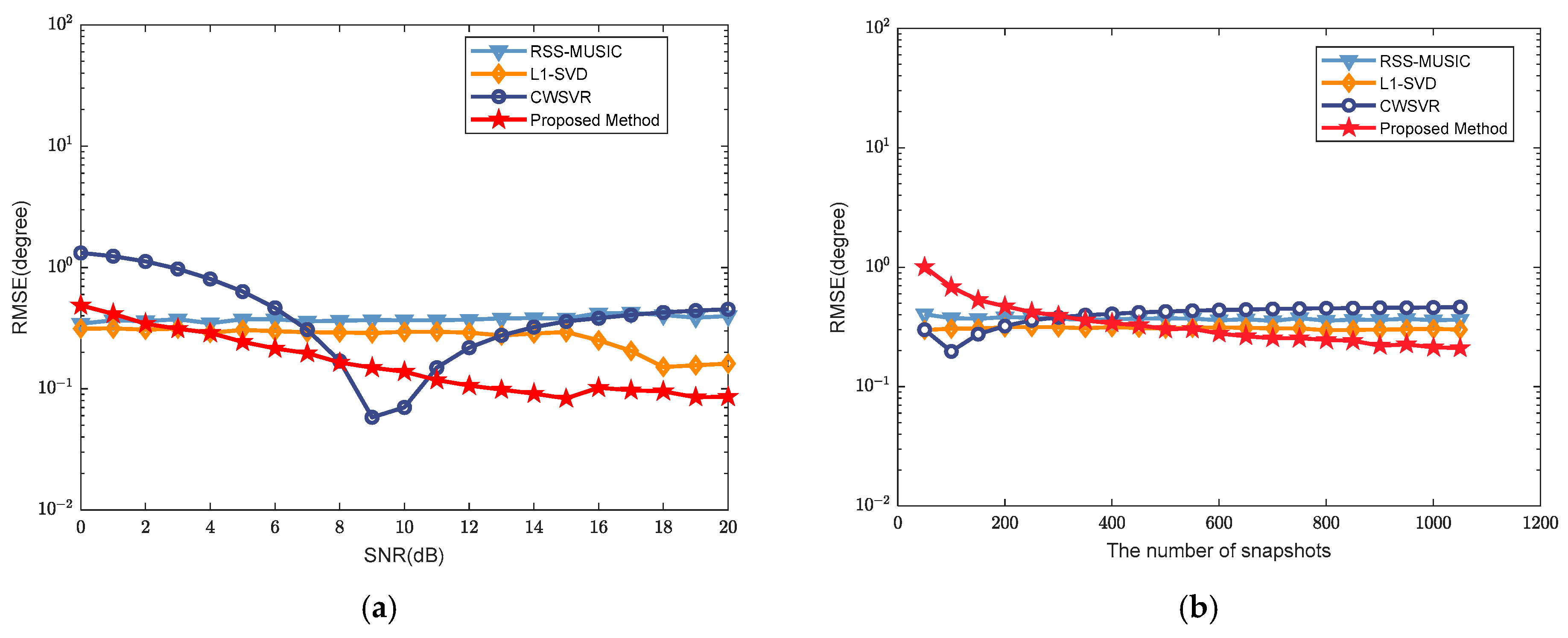
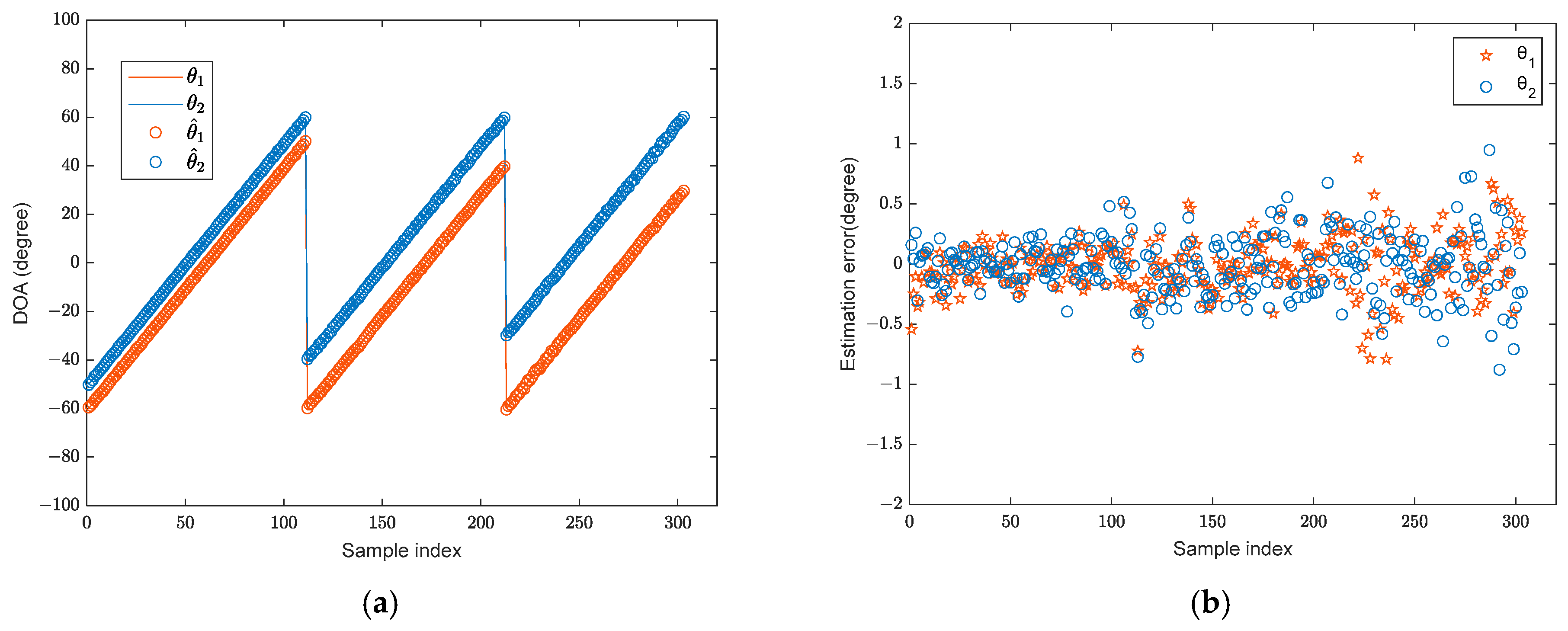

Disclaimer/Publisher’s Note: The statements, opinions and data contained in all publications are solely those of the individual author(s) and contributor(s) and not of MDPI and/or the editor(s). MDPI and/or the editor(s) disclaim responsibility for any injury to people or property resulting from any ideas, methods, instructions or products referred to in the content. |
© 2025 by the authors. Licensee MDPI, Basel, Switzerland. This article is an open access article distributed under the terms and conditions of the Creative Commons Attribution (CC BY) license (https://creativecommons.org/licenses/by/4.0/).
Share and Cite
Zhao, Y.; Zheng, G.; Wang, J.; Liu, J.; Dong, S.; Xin, J. Efficient Support Vector Regression for Wideband DOA Estimation Using a Genetic Algorithm. Sensors 2025, 25, 2915. https://doi.org/10.3390/s25092915
Zhao Y, Zheng G, Wang J, Liu J, Dong S, Xin J. Efficient Support Vector Regression for Wideband DOA Estimation Using a Genetic Algorithm. Sensors. 2025; 25(9):2915. https://doi.org/10.3390/s25092915
Chicago/Turabian StyleZhao, Yonghong, Gang Zheng, Junlong Wang, Jisong Liu, Shuxin Dong, and Jing Xin. 2025. "Efficient Support Vector Regression for Wideband DOA Estimation Using a Genetic Algorithm" Sensors 25, no. 9: 2915. https://doi.org/10.3390/s25092915
APA StyleZhao, Y., Zheng, G., Wang, J., Liu, J., Dong, S., & Xin, J. (2025). Efficient Support Vector Regression for Wideband DOA Estimation Using a Genetic Algorithm. Sensors, 25(9), 2915. https://doi.org/10.3390/s25092915







